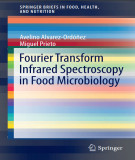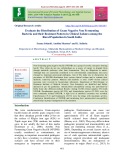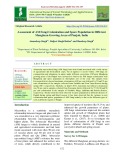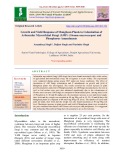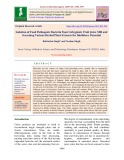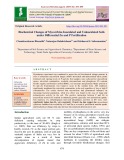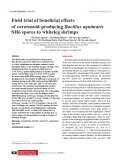
Spore populations
-
Ebook "Fourier transform infrared spectroscopy in food microbiology" will discuss the published experimental techniques, data-processing algorithms, and approaches used in FT-IR spectroscopy to assist in the characterization and identification of microorganisms, to assess the mechanisms of bacterial inactivation by food processing technologies and antimicrobial compounds, to monitor the spore and membrane properties of foodborne pathogens in changing environments, to detect stress-injured microorganisms in food-related environments, to assess dynamic changes in bacterial populations, and to...
 58p
58p  manmanthanhla0201
manmanthanhla0201
 26-02-2024
26-02-2024
 3
3
 1
1
 Download
Download
-
Zooplankton holds a key position in the food web as it was directly related to the consumption of organic energy produced by phytoplanktonic photosynthesis and then by transforming it to the higher tropical levels of hetirotropes such as fish. Some zooplankton population disappeared at a specified period and reappeared during other period. This disappearance may be due to the fact that some species occur in spores, under favorable conditions spore germinate and appear as zooplankton.
 9p
9p  angicungduoc8
angicungduoc8
 07-11-2020
07-11-2020
 13
13
 1
1
 Download
Download
-
Non-fermenting gram negative bacilli (NFGNB) are a group of aerobic, non spore forming bacilli. They either do not use carbohydrates as a source of energy or degrade them through metabolic pathways other than fermentation. They are ubiquitous in nature. Although they are commonly considered to be environmental contaminants, they have emerged as important nosocomial pathogens. Aim of this study was to characterize the prevalence of NFGNB distribution from various clinical isolates and to evaluate their antibiotic sensitivity patterns.
 8p
8p  trinhthamhodang7
trinhthamhodang7
 31-08-2020
31-08-2020
 10
10
 1
1
 Download
Download
-
Arbuscular mycorrhizal fungi (AM fungi) have been found associated with a wide variety of agricultural and horticultural crops, but in legumes it occurs widely. AM fungi are cosmopolitan and ubiquitous in nature under different ecosystems. Different Mungbean growing areas of the Punjab were surveyed to observe the AM fungus colonization with Mungbean and spore population in rhizosphere soil of the crop.
 6p
6p  angicungduoc6
angicungduoc6
 22-07-2020
22-07-2020
 14
14
 2
2
 Download
Download
-
Arbuscular mycorrhizal fungi (AM fungi) have been found associated with a wide variety of agricultural and horticultural crops, but in legumes it occurs widely. The experiments were conducted during spring season 2017 under pot house conditions. The effect of inoculation of AM Fungi colonization and P amendments on growth and yield of Mungbean plants was investigated.
 10p
10p  trinhthamhodang4
trinhthamhodang4
 22-03-2020
22-03-2020
 20
20
 2
2
 Download
Download
-
Studies were undertaken to find out the effect of inoculum load of post harvest pathogen (Penicillium islandicum) on disease initiation, threshold point and population build up of blue mould rot in Indian gooseberry. Inoculations were made on the fruits of Indian gooseberry at five concentrations (10, 50, 100, 200 and 500 spores/ml.). The disease initiation commenced after 54 hrs. of inoculation with inoculum load of 500 spores/ml followed by 200 spores/ml where the initiation of disease was observed after 72 hrs.
 4p
4p  caygaocaolon3
caygaocaolon3
 09-03-2020
09-03-2020
 14
14
 1
1
 Download
Download
-
Microbes are the sources of many food poisoning cases, usually due to improperly processed food and fruit juice separation by hand or juice mill. It is now commonly accepted that fruit juice consumption is a risk factor for infection with enteric pathogens. The trouble begins when certain bacteria and other harmful pathogens spores of multiply and spread in ubiquitous and environments. However, fruit juice Sample was collected from the various places of Kanpur, India and observed the highest microbial load in nutrient agar (4.3X107 ) viz., Shivrajpur, rose bengal chloramphenicol agar (2.
 14p
14p  nguaconbaynhay1
nguaconbaynhay1
 04-12-2019
04-12-2019
 18
18
 1
1
 Download
Download
-
Arbuscular mycorrhizal status of Pippali a medicinal plant species in the Jorhat district of Assam, India were surveyed during 2018. Percent colonization, spore density and diversity of arbuscular mycorrhizal fungi associated with the rhizospheric soil and roots of pippali growing wild as well as under cultivated conditions were investigated. It was found that 100% of the surveyed sample was of mycorrhizal infestation. The spore colonization per cent of AMF ranged from 30.80 to 66.50% spores per 100 g of soil. The maximum spore population (185.
 9p
9p  nguaconbaynhay1
nguaconbaynhay1
 04-12-2019
04-12-2019
 33
33
 0
0
 Download
Download
-
Greenhouse experiment was conducted to assess the soil biochemical change patterns in soils of arbuscular mycorrhizal fungus (AMF)-inoculated and uninoculated maize plants fertilized with varying levels of P and Zn. Soil samples were collected for mycorrhizal spores, microbial communities, available micronutrients and phosphorus (P) contents besides organic and biomass carbon (BMC), soil enzymes and glomalin. Major portion of Fe and Zn fractionations was found to occur in the residual form.
 17p
17p  chauchaungayxua1
chauchaungayxua1
 04-12-2019
04-12-2019
 31
31
 0
0
 Download
Download
-
This field study was performed to demonstrate that Bacillus aquimaris SH6 spores administered as a feed supplement in adequate amounts confer beneficial effects to the whiteleg shrimp. Shrimps were administered either B. aquimaris SH6 spores at 1×106 CFU g-1 pellet (SH6 group) or a mixture of SH6 and B. subtilis SH23 spores at 5×105 CFU g-1 pellet for each strain (SH6-SH23 group). After a 28-day feeding period, the number of SH6 spores in the gut of whiteleg shrimp in the SH6 group and the SH6-SH23 group were 5.7×103 CFU gut-1 and 7.7×103 CFU gut-1, respectively.
 6p
6p  caygaocaolon1
caygaocaolon1
 13-11-2019
13-11-2019
 7
7
 1
1
 Download
Download
CHỦ ĐỀ BẠN MUỐN TÌM









